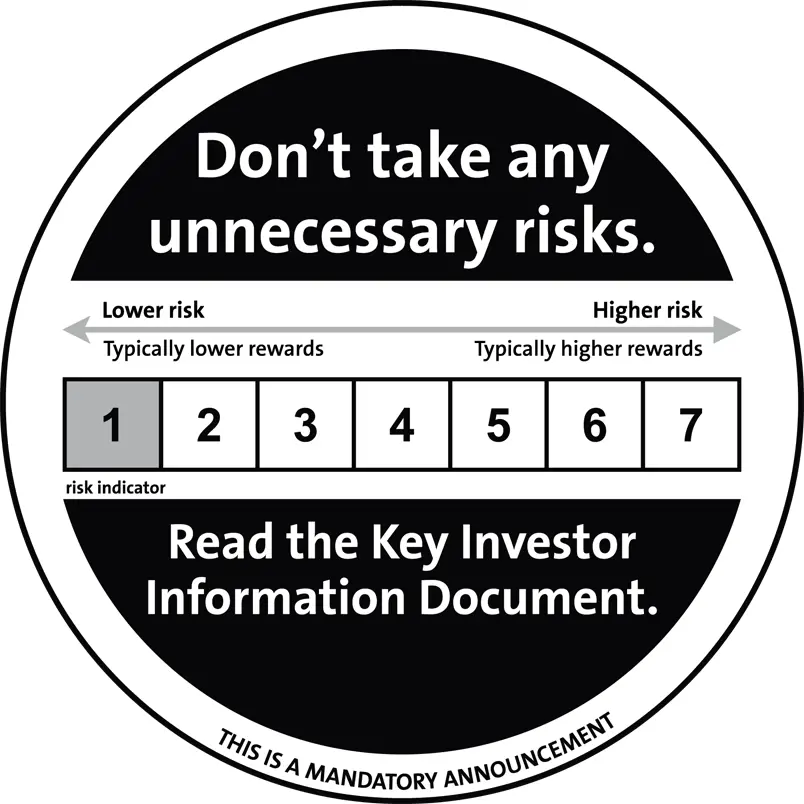

Candriam Money Market Euro
Fund details
“Sustainable Finance Disclosure Regulation” : Regulation 2019/2088 on sustainability-related disclosures in the financial services sector
Marketing Communication. Please refer to the prospectus of the fund and to the key investor information document before making any investment decision. The documents can be obtained free of charge.
Risks
Definition
The summary risk indicator ("SRI") is an indicator with a rating ranging from 1 to 7 and corresponds to increasing levels of risk and return. The methodology for calculating this regulatory indicator is available in the KID.
The summary risk indicator ("SRI") is a guide to the level of risk of this product compared to other products.
It shows how likely it is that the product will lose money because of movements in the markets or because we are not able to pay you.;
The summary risk indicator ("SRI") is an indicator with a rating ranging from 1 to 7 and corresponds to increasing levels of risk and return. The methodology for calculating this regulatory indicator is available in the KID.<br>The summary risk indicator ("SRI") is a guide to the level of risk of this product compared to other products.<br> It shows how likely it is that the product will lose money because of movements in the markets or because we are not able to pay you.
Historical NAV
Candriam Money Market Euro
Historical NAV
€STR (Euro Short Term Rate) Capitalized
C Dis
This graph represents the synthetic net asset value of the fund. It is provided for information and illustrative purposes only. The synthetic net asset value is obtained by a recalculation of the values of the fund’s assets by leveling out the effect of securities transactions (split, coupon, dividend distribution...) in order to reflect the real performance of the fund share or unit. Data may be rounded for convenience. Data expressed in a currency other than that of the investor's country of residence is subject to exchange rate fluctuations, with a positive or negative impact. Gross performance may be impacted by commissions, fees and other expenses.
Legal documents
About this fund
Money market instruments and/or bonds with a residual maximum maturity of less than 397 days and with an interest rate that can be revised at least annually, denominated in euros and in currencies of member countries of the Organisation for Economic Co-operation and Development (OECD), and issued by all types of issuers rated at least A2/P2 (or equivalent) by one of the rating agencies (i.e. issuers considered good quality).
Deposits.
Investment strategy:
The fund seeks to achieve capital growth, associated with a low risk level, by investing in the principal assets traded.
Within the limits of the fund’s investment objective and policy, the management team makes discretionary investment choices in the portfolio based on its analyses of the characteristics and growth prospects of the assets traded. The duration (Weighted Average Maturity - WAM), i.e. the sensitivity of the fund to changes in interest rates, will not exceed 6 months and the weighted average life of the fund assets (Weighted Average Life - WAL) will not exceed 12 months.
The fund promotes, among other characteristics, environmental and/or social characteristics but does not have sustainable investment as its objective. Environmental, social and governance (ESG) criteria contribute to the asset manager's decision-making but are not a decisive factor in this decision-making. For more information, please see the management company's website and/or the prospectus.
The fund may only make use of derivative products for hedging purposes (to protect against future unfavourable financial events).
Benchmark: €STR (Euro Short Term Rate) Capitalized.
The fund is managed actively and the investment approach implies a reference to a benchmark (the index).
Benchmark definition:
The €STR is the short term rate in euros that reflects unsecured overnight borrowing costs in euros for banks in the euro zone.
Use of the benchmark:
- to compare performance.
Investment Team



Historical NAV
Historical NAV
Candriam Money Market Euro
Historical NAV
€STR (Euro Short Term Rate) Capitalized
C Dis
This graph represents the synthetic net asset value of the fund. It is provided for information and illustrative purposes only. The synthetic net asset value is obtained by a recalculation of the values of the fund’s assets by leveling out the effect of securities transactions (split, coupon, dividend distribution...) in order to reflect the real performance of the fund share or unit. Data may be rounded for convenience. Data expressed in a currency other than that of the investor's country of residence is subject to exchange rate fluctuations, with a positive or negative impact. Gross performance may be impacted by commissions, fees and other expenses.
Cumulative Return
Past performance is not a reliable indicator of future performances. Markets could develop very differently in the future.
It can help you assess how the fund has been managed in the past.
| 1 Year | 3 Year | 5 Year | 10 Year | |
|---|---|---|---|---|
| Fund | 3,53 | 1,52 | 0,51 | -0,07 |
| Benchmark | 3,98 | 2,02 | 1,01 | 0,36 |
| Difference | -0,44 | -0,49 | -0,50 | -0,43 |
Additional information
The returns listed above are provided on the basis of the Net Asset Value (NAV), net of commissions and reinvested income. All management fees and commissions are included in the calculation of past performance except for any entry and exit charges. Taxes are not included in the calculation of returns. The value or price converted into euros may be reduced or increased depending on fluctuations in the exchange rate. The fund is not a guaranteed investment. The NAVs are net of fees and are provided by the accounting department and the benchmark by the official providers.
Market developments (currency conversion, coupon, split, …) have an influence on the chart. This graph is provided for information purposes only and does not precisely illustrate the evolution of the fund's net assets. Data may be rounded for convenience. Data expressed in a currency other than that of the investor's country of residence is subject to exchange rate fluctuations, with a positive or negative impact. Gross performance may be impacted by commissions, fees and other expenses
Annual return
This chart shows the fund’s performance as the percentage loss or gain per year over the last 10 years.
It can help you to assess how the fund has been managed in the past and compare it to its benchmark.
The index composition may change over time. The performance reported may therefore differ from the performance of the relevant index before its change. Performance is shown after deduction of ongoing charges. Any entry and exit charges are excluded from the calculation. Performances expressed in a currency other than that of the investor's country of residence are subject to exchange rate fluctuations, with a negative or positive impact on gains. If the present document refers to a specific tax treatment, such information depends on the individual situation of each investor and may change. If for one year, there is no performance information, it is because there is no data or the data is insufficient to provide investors with useful or reliable indications on this performance.
| 2014 | 2015 | 2016 | 2017 | 2018 | 2019 | 2020 | 2021 | 2022 | 2023 | |
|---|---|---|---|---|---|---|---|---|---|---|
| Fund | -0,01 % | -0,46 % | -0,56 % | -0,78 % | -0,84 % | -0,88 % | -0,88 % | -1,09 % | -0,55 % | 2,80 % |
| Benchmark | 0,10 % | -0,11 % | -0,32 % | -0,36 % | -0,37 % | -0,40 % | -0,47 % | -0,51 % | -0,01 % | 3,29 % |
| Difference | -0,10 % | -0,36 % | -0,23 % | -0,42 % | -0,48 % | -0,48 % | -0,41 % | -0,58 % | -0,53 % | -0,48 % |
Additional information
The returns listed above are provided on the basis of the Net Asset Value (NAV), net of commissions and reinvested income. All management fees and commissions are included in the calculation of past performance except for any entry and exit charges. Taxes are not included in the calculation of returns. The value or price converted into euros may be reduced or increased depending on fluctuations in the exchange rate. The fund is not a guaranteed investment. The NAVs are net of fees and are provided by the accounting department and the benchmark by the official providers.
Market developments (currency conversion, coupon, split, …) have an influence on the chart. This graph is provided for information purposes only and does not precisely illustrate the evolution of the fund's net assets. Data may be rounded for convenience. Data expressed in a currency other than that of the investor's country of residence is subject to exchange rate fluctuations, with a positive or negative impact. Gross performance may be impacted by commissions, fees and other expenses

Main Risks
-
Counterparty Risk
When the fund carry out over-the-counter transactions (i.e. involving instruments not listed on the markets), they are exposed to a risk of default by the counterparty to the transaction.
-
Credit risk
It constitutes the risk that an issuer or a counterparty default. This risk includes the risk of changes in credit spreads and default risk. The level of credit risk is usually evaluated by using “ratings” representing a comparative assessment of the credit quality (solvency level) of an issuer, issuer or portfolio. “High Yield” investments present the lowest rating levels and therefore a high credit risk.
-
ESG Investment Risk
ESG investment risk refers to the risks arising from the inclusion of ESG factors in the management process, such as the exclusion of activities or issuers and the inclusion of sustainability risks in the selection and/or allocation of issuers in the portfolio.
-
Sustainability Risk
The sustainability risk refers to any environmental, social or governance event or condition that could affect the performance and / or the reputation of issuers in the portfolio. It may be issuer specific, in line with their activities and practices, but may also be due to external factors.
Other Risks
-
Conservation risk
The insolvency, negligence or fraudulent acts of a custodian or a sub-custodian may result in the loss of assets. This risk is mitigated by the regulatory obligations of the depositaries.
-
Delivery risk
In case of liquidation of assets that are subject to a transaction with a counterparty, this last, although contractually obliged, may not be able in operational terms to return the assets quickly enough to allow the fund to honour the sale of these instruments on the market..
-
Derivative risk
Derivatives are investments whose value depends on (or is derived from) the value of an underlying instrument, such as a security, asset, reference rate or index. Derivative strategies often involve leverage, which may exaggerate a loss, potentially causing the Sub-Fund to lose more money than it would have lost had it invested in the underlying instrument. Using derivatives may result in a higher portfolio volatility related to this underlying asset and an increase of the counterparty risk.
-
Interest rate risk
A change in interest rates, resulting notably from inflation, may cause a risk of losses and reduce the net asset value of the fund.
-
Legal risk
Litigations of all kinds can occur with a counterparty or a third party. The Management Company aims to reduce these risks by putting in place controls and procedures.
-
Liquidity risk
lt occurs when a portfolio position cannot be sold, liquidated or closed at a limited cost and within a sufficiently short time, which jeopardizing the fund's ability to comply at any time with its obligations to redeem the shares of investors at their request.
-
Operational risk
Operational risk encompasses the risks of direct or indirect loss related to a number of factors (eg human errors, fraud and malicious acts, information system failures and external events, etc.) that could have an impact on the fund and / or the investors. The Management Company aims to reduce this risk through the implementation of controls and procedures.
-
Risk of conflict of interest
The selection of a counterparty based on reasons other than the sole interest of the fund and/or unequal treatment in the management of similar portfolios can result in conflicts of interest.
-
Risk of loss of capital
Investors are advised that any capital they invest is not guaranteed and that they may therefore not receive back the full amount invested. They may thus suffer a loss.
Risk And Reward Indicators 30/9/24
- Beta
-
0.99
- Information ratio
-
-7.25
- Sharpe Ratio
-
-1.75
- Tracking error
-
0.07 %
- Volatility
-
0.28 %
- Yield to Worst
-
1.77
Money Market
Money Market Fund Metrics (29/10/24)
|
Weighted Average Maturity, in days (WAM)
‘weighted average maturity’ or ‘WAM’ means the average length of time to legal maturity or, if shorter, to the next interest rate reset to a money market rate, of all of the underlying assets in the MMF reflecting the relative holdings in each asset.) |
70 |
|
Weighted Average Life, in days (WAL)
‘weighted average life’ or ‘WAL’ means the average length of time to legal maturity of all of the underlying assets in the MMF reflecting the relative holdings in each asset.) |
152 |
| Net Yield (%) | 2.97999999970198 |
| Total Value of Assets | 1.642.708.326,54 |
This is the portfolio partial view
-
75%
Min Investments Environmental Social characteristics rate -
20%
Min sustainable investments rate -
0%
Min sustainable investments environmental rate -
0%
Min sustainable investments social rate
Fund Characteristics
- Fund name
- Candriam Money Market Euro
- Benchmark
- €STR (Euro Short Term Rate) Capitalized
- Share Class
- C - Dis
- SICAV Name
- Candriam Money Market
- Currency
- EUR
- Legal Form
- Sub-fund of a SICAV under Luxembourg law
- Legal status
- UCITS
- SFDR Category
- Article 8
- Creation Date
- Closing date
- The fund has no limited term
- Domicile Country
- Luxembourg
- First NAV Date
- 29/1/99
- Bloomberg ticker
- DXMMKED LX Equity
- Morningstar ticker
- F0GBR04BEE
- Management company, having its registered office in Luxembourg
- CANDRIAM, management Company having its registered office in Luxembourg.
- Depository bank
- CACEIS Bank, Luxembourg Branch
- Transfer agent
- CACEIS Bank, Luxembourg Branch
- Recommended investment horizon
- 6 months
- Anti Dilution system
- no
- ISIN
- LU0093583234
- Marketing authorization
- Austria; Belgium; Denmark; Finland; France; Germany; Ireland; Luxembourg; Netherlands; Spain; Sweden; Switzerland
Swing Pricing is a mechanism by which the net asset value is adjusted upwards (or downwards) if the change in liabilities is positive (or negative) in such a way as to reduce for existing investors the portfolio restructuring costs linked to subscription/ redemption movements in the fund. On valuation days where the difference between the amount of subscriptions and the amount of redemptions of a sub-fund (i.e. net transactions) exceeds a threshold set beforehand by the Board of Directors, the latter shall be entitled to:
- value the net asset value by adding to the assets (in the case of net subscriptions) or deducting from assets (at net redemptions) a fixed percentage of the fees corresponding to market practices and reflecting the fees and/or conditions of liquidity when buying or selling securities;
- value the securities portfolio on the basis of bid or ask prices;
- assess the net asset value by setting a level of spreads representative of the relevant market;
- The dilution mechanism must not exceed 2% of the net asset value, except in exceptional circumstances, as in the event of a sharp decrease in liquidity, which would then be detailed for the sub-fund concerned in the annual (semi-) annual report of the SICAV.
Tax, Charges & Fees
- Management fees (max)
- 0.50 %
- Redemption
- 0.00 %
- Ogc date
- Last ogc
- 0.69 %
Orders
- NAV date
- D
- NAV calculation Day
- D+1
- Frequency valuation
- daily
- Subscription cut off
- D 12:00
- Redemption cut off
- D 12:00
ESG documents
Download all ESG documentsShareholder Documents
Download all shareholder documentsAnnual and semi-annual reports
Download all annual documentsFactsheet and Fund Comments
Download all fact sheet documentsAwards
Other information
This is a marketing communication. Please refer to the prospectus of the funds and to the key information document before making any investment decision. This marketing communication does not constitute an offer to buy or sell financial instruments, nor does it represent an investment recommendation or confirm any kind of transaction, except where expressly agreed. Although Candriam selects carefully the data and sources within this document, errors or omissions cannot be excluded a priori. Candriam cannot be held liable for any direct or indirect losses as a result of the use of this document. The intellectual property rights of Candriam must be respected at all times, contents of this document may not be reproduced without prior written approval.
Warning: Past performance of a given financial instrument or index or an investment service or strategy, or simulations of past performance, or forecasts of future performance does not predict future returns. Gross performances may be impacted by commissions, fees and other expenses. Performances expressed in a currency other than that of the investor's country of residence are subject to exchange rate fluctuations, with a negative or positive impact on gains. If the present document refers to a specific tax treatment, such information depends on the individual situation of each investor and may change.
In respect to money market funds, please be aware that an investment in a fund is different from an investment in deposits and that the investment’s principal is capable of fluctuation. The fund does not rely on external support for guaranteeing its liquidity or stabilizing its NAV per unit or share. The risk of loss of the principal is borne by the investor.
Candriam consistently recommends investors to consult via our website https://www.candriam.com the key information document, prospectus, and all other relevant information prior to investing in one of our funds, including the net asset value (“NAV) of the funds. Investor rights and complaints procedure, are accessible on Candriam’s dedicated regulatory webpages https://www.candriam.com/en/professional/legal-information/regulatory-information/. This information is available either in English or in local languages for each country where the fund’s marketing is approved.
According to the applicable laws and regulations, Candriam may decide to terminate the arrangements made for the marketing of a relevant fund at any time.
Information on sustainability-related aspects: the information on sustainability-related aspects contained in this communication are available on Candriam webpage https://www.candriam.com/en/professional/sfdr/. The decision to invest in the promoted product should take into account all the characteristics or objectives of the promoted product as described in its prospectus, or in the information documents which are to be disclosed to investors in accordance with the applicable law.
ESG Assessment
The fund’s investment strategy aims to promote environmental or social characteristics, or a combination of these characteristics, provided that the entities in which the investments are made apply good governance practices. To achieve this objective, the management team makes discretionary investment choices based on an economic/financial analysis process and an internal analysis of environmental, social and governance (ESG) criteria, based in part on data provided by external service providers.
a. ESG selection criteria:
For corporates, the internal analysis of ESG criteria consists in selecting the issuers:
• that are the best positioned to meet the challenges of sustainable development;
• that comply with the principles of the United Nations Global Compact (i.e. human rights, labour law, the environment, anti-corruption), and which are therefore less exposed to the risks associated with these themes; and
• that are not engaged in controversial activities such as armament (securities of a company whose activity consists of manufacturing, the use or possession of anti-personnel mines, cluster bombs and/or depleted uranium weapons), tobacco, thermal coal.
For sovereign issuers, the internal analysis of ESG criteria consists in selecting:
• Countries that perform best across our four categories of sustainable development criteria: Human Capital, Natural Capital, Social Capital and Economic Capital;
• Countries that are not part of our highly Oppressive Regimes or dictatorships, based on the Freedom House Freedom in the World Index and the World Bank Voice & Accountability Index.
b. Selection methodology:
The issuers favoured by the management company are subject to a dual analysis:
• Analysis of their activity to assess their alignment with the major challenges of sustainable development. For example, regarding the transition to a circular economy, the management company will consider a company producing recycled steel to be more sustainable than a company producing steel exclusively from iron ore; and
• Analysis of how the company manages players interacting with the company: its employees, its customers, its shareholders, its suppliers and the environment. Here too, the management company will favour companies that adopt the most sustainable practices given their sector. For example, with regard to relations with its clients, the management company will favour pharmaceutical companies with balanced pricing practices and commercial policies. Similarly, with regard to relations with their employees, the management company attaches great importance to the fight against discrimination and compliance with social standards.
Our sovereign investible universe consists of those countries which perform best across our four categories of sustainable development criteria:
• Natural Capital: stock of naturel resources managed by the country;
• Social Capital: trust, norms and institutions which people can rely on to solve common problems and create social cohesion;
• Human Capital: human productivity to which the country participates through education and other initiatives;
• Economic Capital: assessing the level of economic activity viability.
c. A team of ESG analysts is responsible for assessing the selection criteria:
ESG analysis and selection are carried out by a dedicated team of ESG analysts within Candriam. This team is made up of specialists whose mission is to analyse the exposure of companies and governments to the risks and opportunities associated with sustainable development. Selection criteria are expected to evolve over time, based on advances in ESG research and changes in company practices.